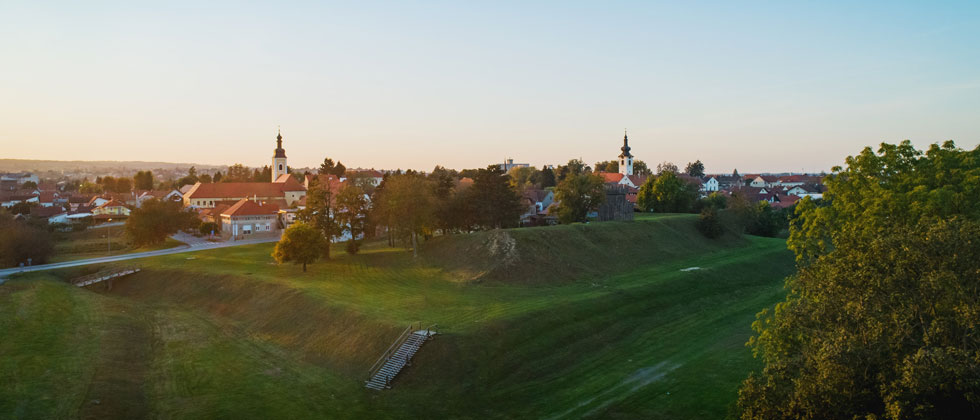
History of Koprivnica
13TH CENTURY
Koprivnica was named after a stream Koprivnica mentioned in the charters of Croato-Hungarian King Andrew II. Arpad from the 1207., 1209. and 1217. The settlement was first mentioned in 1272. in the grant of 10-years old prince Ladislav IV Kumanec to Bakaler, the commander and the knight of the Koprivnica fortress. In 1292. Franciscans arrive at the invitation of governor Henry Gising and build the monastery and the parish church of the Blessed Virgin Mary.
14TH CENTURY
It was the golden century in the development of the city. Koprivnica is then confirmed as the urban centre of the mid- Drava region, but also as a significant and respectable city in the D’Anjouvian Slavonia. This primarily refers to the local social arrangements, the economic strength of the settlement and its role at the famous busy road of King Coloman, confirmed by over twenty preserved medieval charters issued over the century. The most important among them is the charter of King Ludovic D’Anjou of 4 November 1356. in which is proclaimed a free and royal city. The charter followed the pattern of legal privileges written for the Gradec of Zagreb.
15TH CENTURY
During the 15th century, the town was under the rule of King Sigismund of Luxembourg, Ivan Alben, Bishop of Zagreb and the Counts of Celje, King Matthias Corvinus and Governor Ernust. An important role in the life of the region was played by the fort Kamengrad on the northern slopes of Bilogora hills until the conflict among noblemen in 1446.
16TH CENTURY
On 23 September 1526., less than a month after the Battle of Mohacs, fought between the Croato-Hungarian and Ottoman armies, an Assembly of Kingdom of slavonia was held at the court of Ernust. It elected the Governor Krsto Frankopan Brinjski as the “guardian and defender,” of the kingdom. From the middle of 16th century, Koprivnica was a fortified captaincy of Slavonian Krajina with Generalate headquarters in Varazdin. In accordance with the latest military solutions of counter-cannon defence, the fortress of Koprivnica was streamlined by north-Italian and Dutch architects.
17TH CENTURY
Until 1760s the Renaissance earthen anti-Muslim fortification had become the most modern fortress between the rivers Sava and Drava, defending the so-called „remains of the remains“ of the Croatian kingdom. The 1730s mark the beginning of the economic and demographic renewal. At the end of the century, the city has three craft guilds – the mixed blacksmith, locksmith, swordmaker, saddler and goldsmith guild as well as the bootmaker and the butcher guilds which supplied the military garrison of the fortress and the civilian population of the city and its surroundings with their products.
18TH CENTURY
The Baroque restauration of the city takes place during the century. Inside the fortress brick buildings are constructed, while the new parts of the town grow at the northern and northwestern edges of the fort. By the Decision of the Habsburg Empress Maria Theresa in 1765, the Generalate headquarters moved from Koprivnica to Bjelovar and Koprivnica gets isolated from from the Slavonian Krajina area.
19TH CENTURY
New economic development of the city starts in 1870. when the railway line Budapest-Zakany-Koprivnica – Zagreb was established as a part of Austro-Hungarian traffic policy. The line soon stretched as far as the port of Rijeka. The social and the public life of the city – theatre, library, political parties, the city newspaper- express the ideas of the committed citizenry of Koprivnica.
20TH CENTURY
At the time of Mayor Josip Vargović between 1906 and 1913 . the process of industrial development of the city begins. The factory of chemical products Danica d.d. was built.Its business strongly influenced the dynamics and the structure of the economy of the city until 1930s. In the second half of the century, the growth and development of the town and the Drava region was dominated by Podravka, food processing industry. It is currently an international of high reputation.
Following two World Wars and several social and political systems in which Croatia was demanding its equal position among democratic countries of Europe in 20th century, a referendum of citizens in 1991. requested the national liberation. The vast majority of 96 % of the voters in Koprivnica area voted for the proposal of Croatia as a soverign state. This decision was confirmed by participation of numerous citizens of Koprivnica in the Croatian Liberation war of 1991. – 1995.
Drazen Ernecic, curator
Museum of the City of Koprivnica


